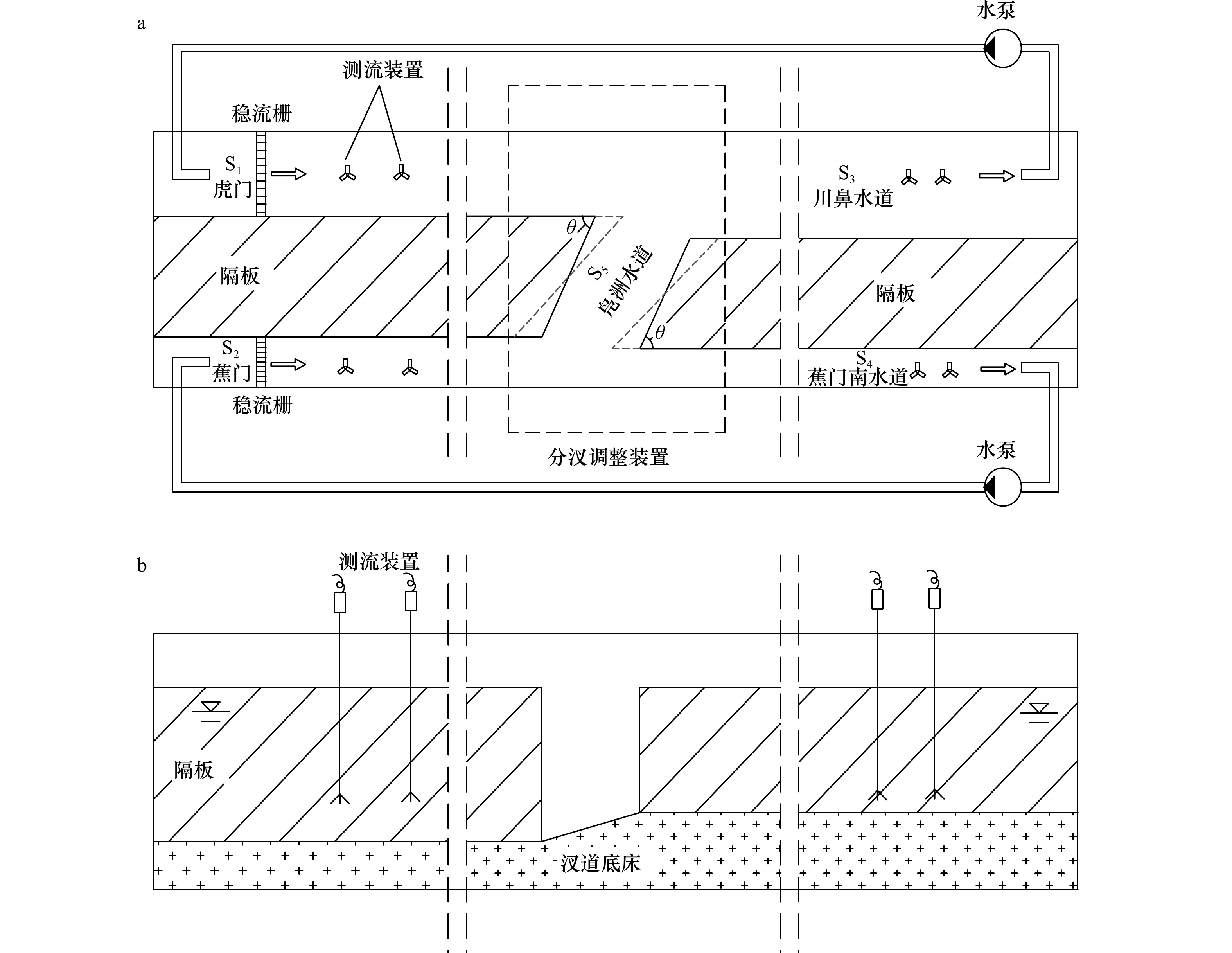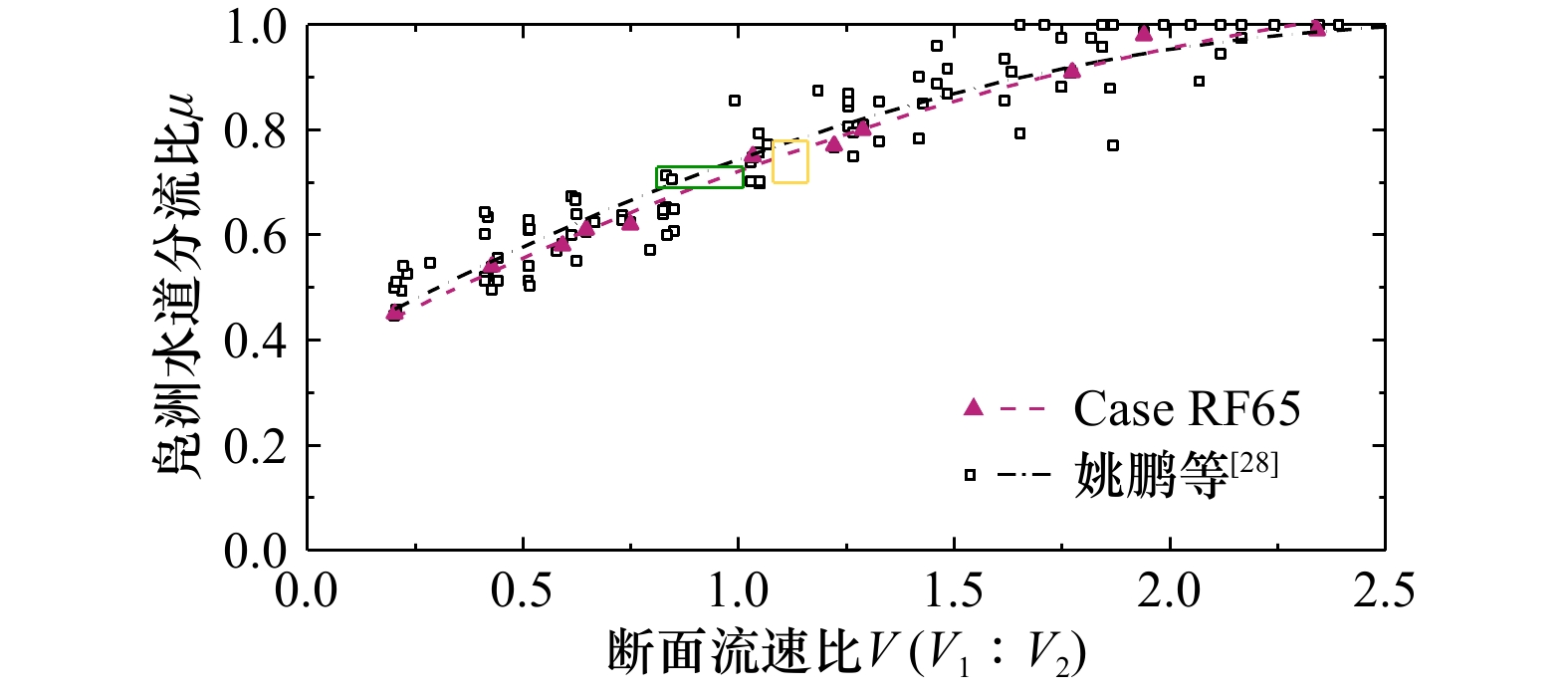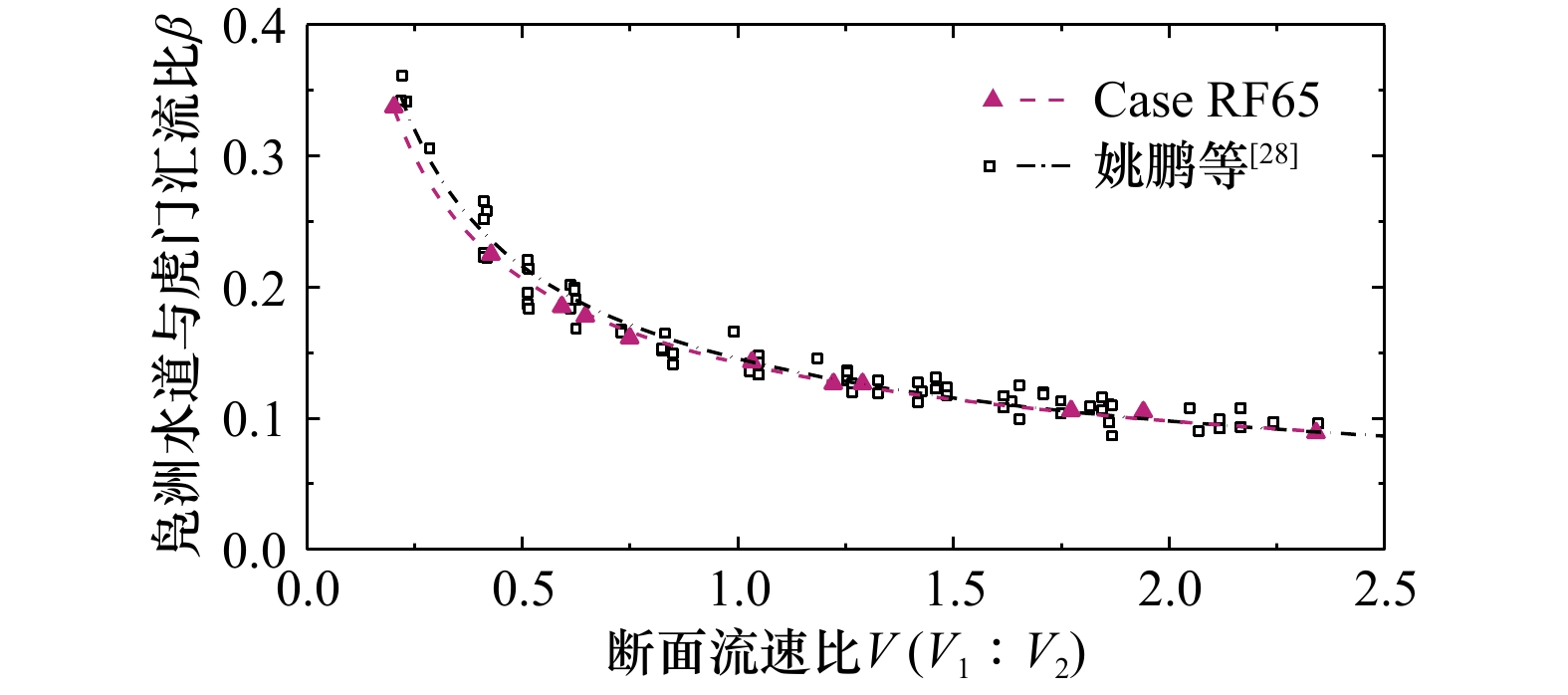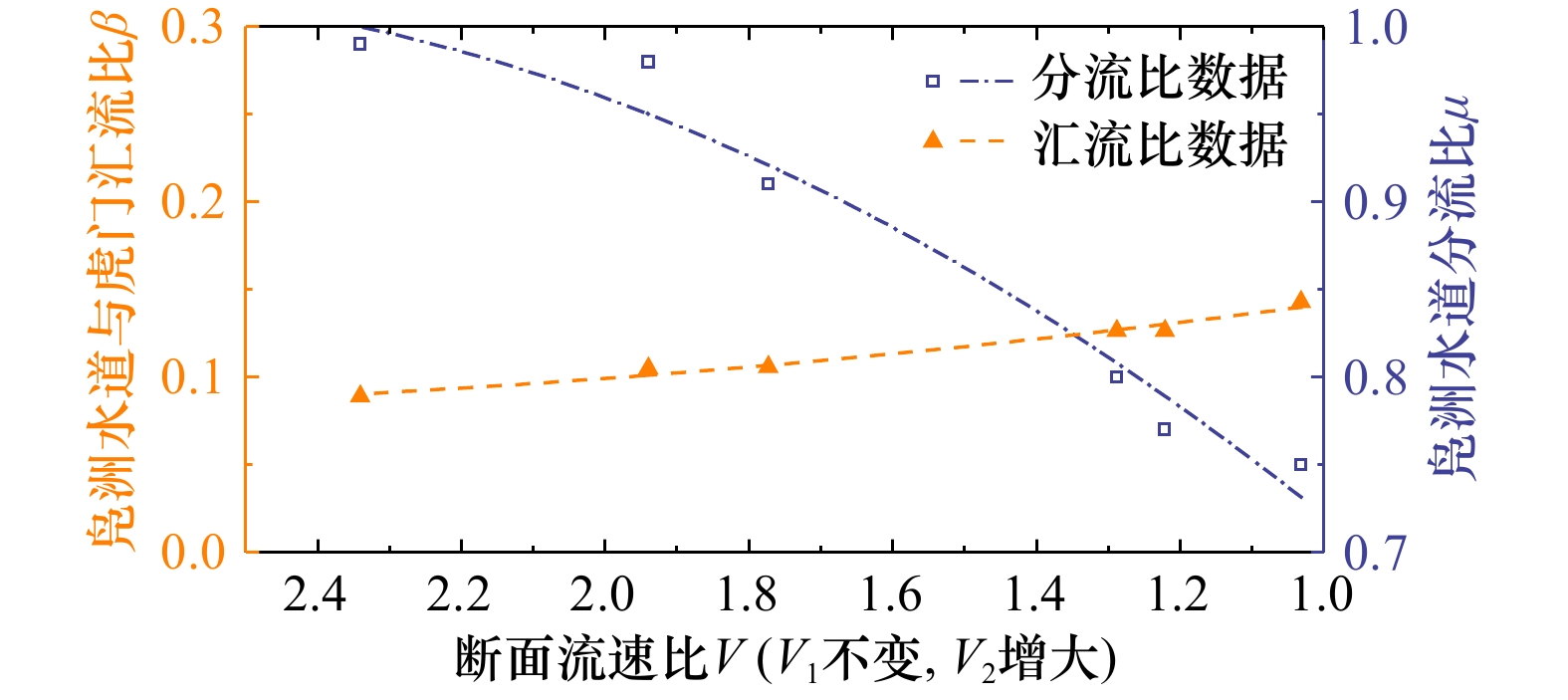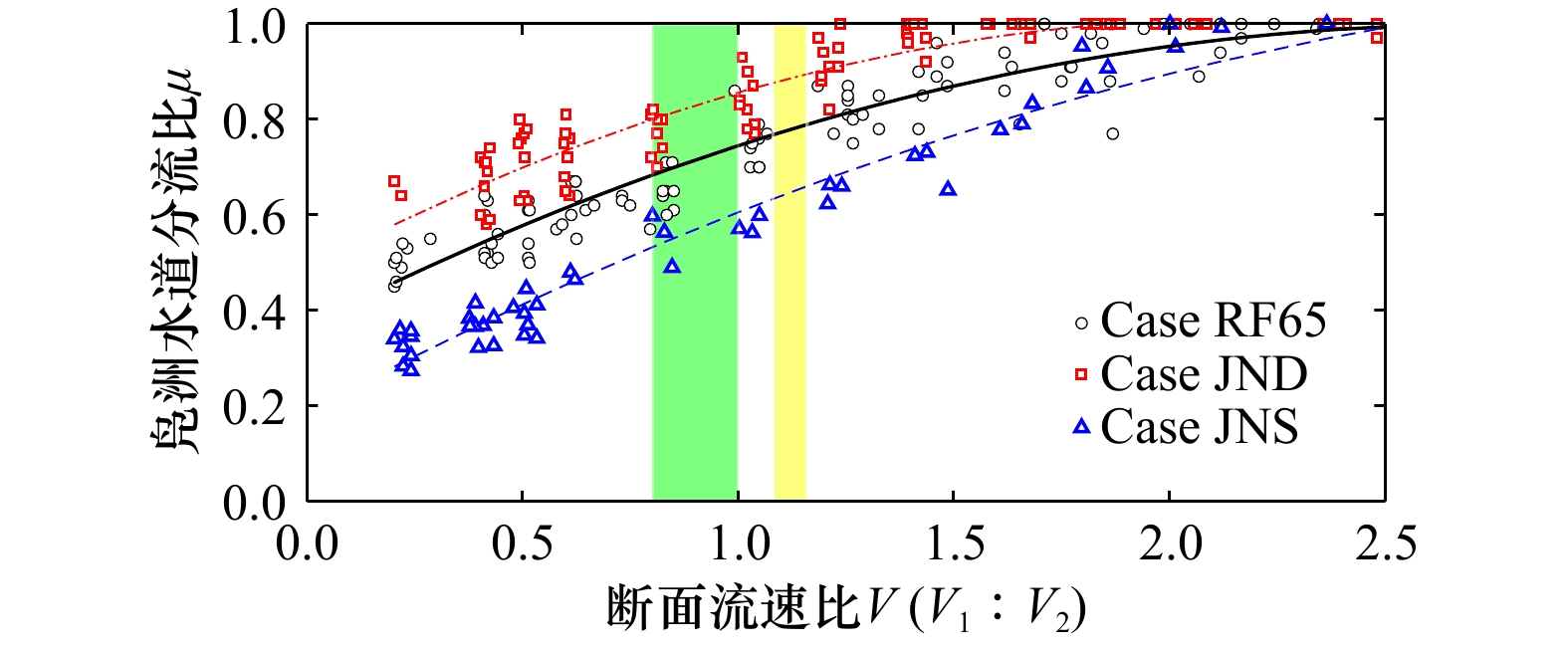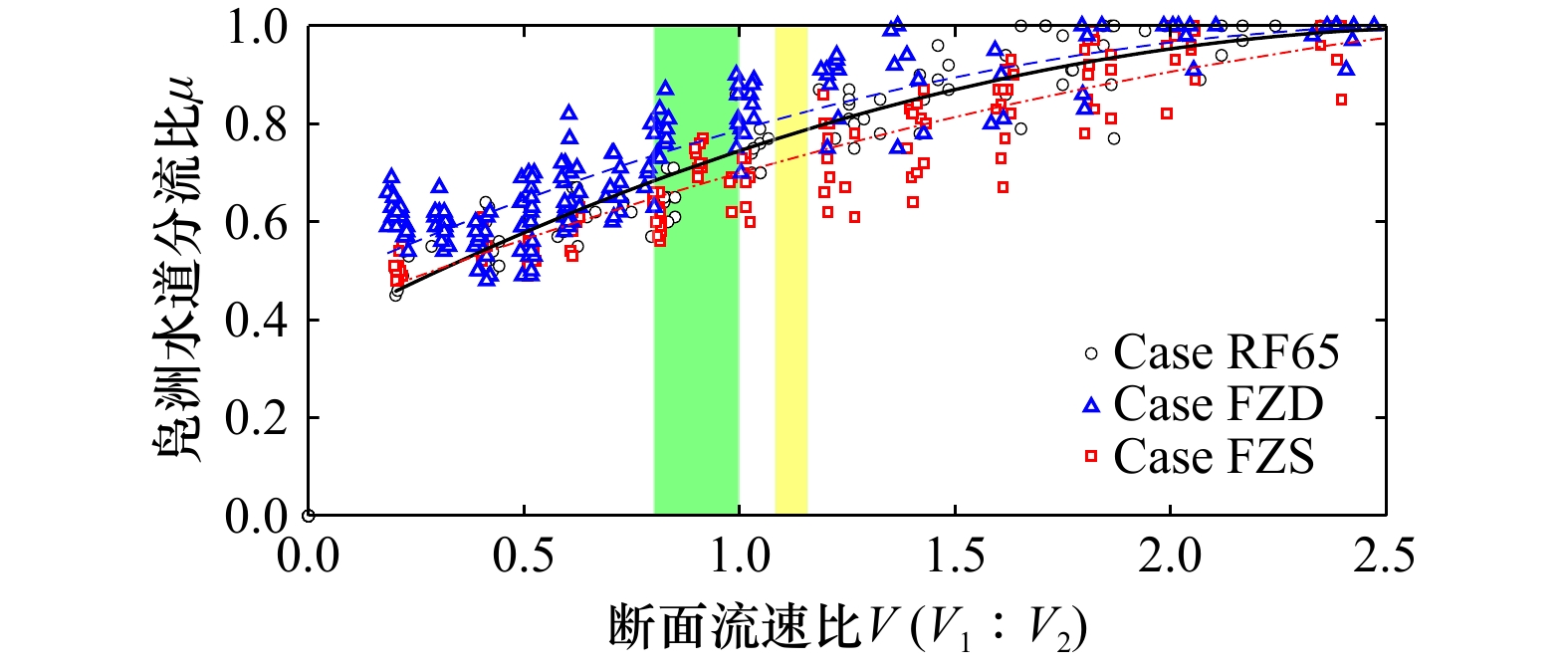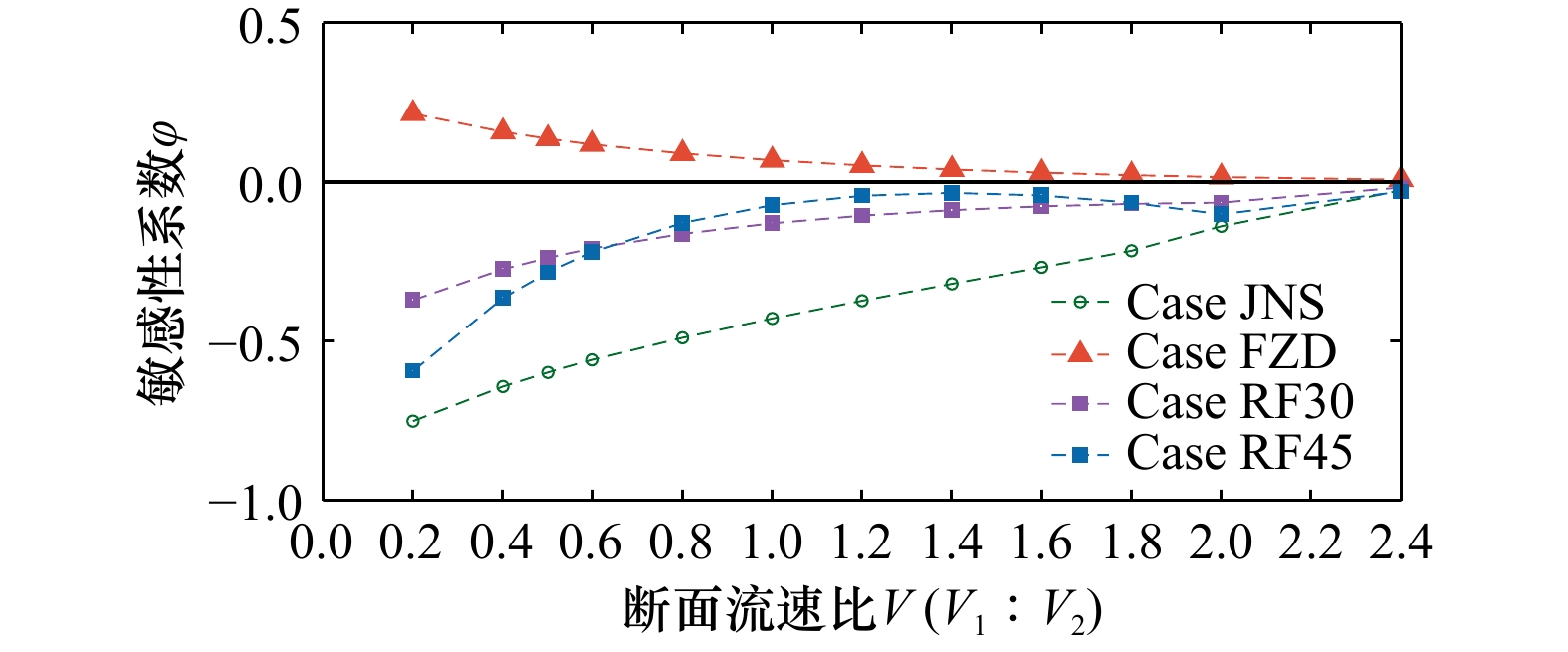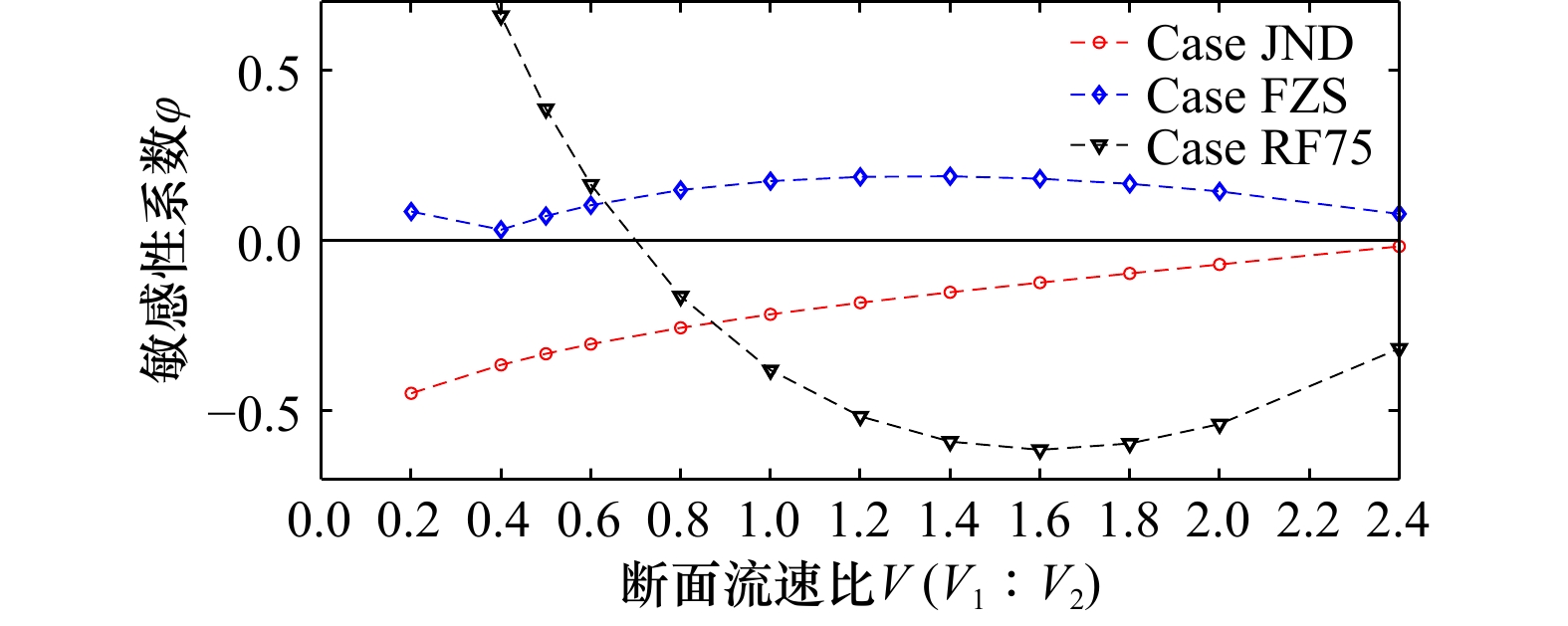Research on the effect factors of flow division ratio in river networks bifurcated estuary: A case of Jiaomen outlet, the Zhujiang River Delta
-
摘要: 珠江蕉门河口是典型的河网型分汊河口,是珠江口重要的泄洪排沙通道,其分流比变化对珠江三角洲地貌演变、防洪与航运等至关重要。本文基于蕉门近期地貌形态,以凫洲水道落潮分流比为研究对象,设计系列水槽实验,选取分汊河道断面形态与分汊角两个影响因素进行敏感性分析,探究河网型分汊河口分流比随上述因子的演变规律。结果表明:在分汊河道断面形态稳定的基础上,凫洲水道分流比与虎门、蕉门相对流速有较好的相关关系,受两口门绝对流速的影响较小;分流比与蕉门南水道水深呈负相关,与凫洲水道水深呈正相关;分汊角在30°~65°区间内,分流比与分汊角呈负相关,分汊角在65°~75°时,分流比与分汊角的正负相关关系在流速比V = 0.7前后转换;通过量化各变量敏感性,分别得到凫洲水道分流比增大或减小对上述因子的敏感性大小。研究成果可为蕉门整治工程提供参考依据。Abstract: Jiaomen outlet is a typical river network bifurcated estuary and an important channel for flood discharge and sediment discharge of the Zhujiang River. The change of diversion ratio in bifurcated Jiaomen outlet is crucial to the geomorphological evolution, flood control and navigation safety of the Zhujiang River Delta. This study designed a series of flume experiments, and selected sensitivity analysis parameter which includes the water depth of bifurcated channel and bifurcated angle to explores the evolution of the flow division ratio of the river network type bifurcated estuary with the above factors. The dimension of the physical model is based on the recent geomorphic morphology of Jiaomen outlet. The result show that, on the basis of the stability of the section feature of the bifurcated channel, the flow division ratio of Fuzhou Channel depicts a good correlation with the flow velocity ratio between Humen and Jiaomen, and is less affected by the absolute flow velocity of the two outlets. Subsequently, the sensitivity experiment result indicate that the flow division ratio is negatively correlated with the water depth of Jiaomen South Channel and positively correlated with the water depth of Fuzhou Channel, and when the bifurcation angle is between 30° and 65°, the flow division ratio is negatively correlated with the bifurcation angle, but when the bifurcation angle is between 65° and 75°, the positive and negative correlation between the flow division ratio and the bifurcation angle changes around the velocity ratio V = 0.7. Then, the sensitivity of the increase or decrease of the flow division ratio to the above each variable can be obtained by quantifying the sensitivity experiment result. The research results can provide reference for artificial regulation project of Jiaomen outlet.
-
表 1 基准实验流速比工况设计表
Tab. 1 Flow velocity ratio setting in the reference run
工况 V1/(cm·s−1) V2/(cm·s−1) V1/V2 1 2.8 14 0.2 2 5.6 14 0.4 3 7 14 0.5 4 8.4 14 0.6 5(基准工况) 11.2 14 0.8 6(基准工况) 14 14 1 7 14 11.7 1.2 8 14 10 1.4 9 14 8.8 1.6 10 14 7.8 1.8 11 14 7 2 12 14 5.8 2.4 表 2 敏感性分析实验参数设计表
Tab. 2 Parameter setting of sensitivity experimental scenarios
参数变化 组次 S4相对水深比
(蕉门南水道)S5相对水深比
(凫洲水道)分汊角 基准实验 Case RF65 1 1 65° 蕉门南水道水深 Case JND 1.86 Case JNS 0.65 凫洲水道水深 Case FZD 1 1.86 Case FZS 0.65 分汊角 Case RF30 1 30° Case RF45 45° Case RF75 75° 注:相对水深比指敏感性分析实验中的水深与基准实验中的水深之比。 表 3 各组实验中凫洲水道主支汊转换及支汊消亡的流速比阈值
Tab. 3 Threshold of velocity ratio for the Fuzhou Channel turn to secondary branch and threshold of velocity ratio for the shrivel of current secondary branch
组次 主支汊转换流速比 蕉门南水道消亡流速比 Case RF65(基准实验) 0.30 1.65 Case JND 0.72 2.02 Case JNS 0.03 1.18 Case FZD 0.09 1.53 Case FZS 0.29 1.96 Case RF30 0.07 1.46 Case RF45 0.06 1.59 Case RF75 / 2.15 -
[1] 金元欢, 沈焕庭. 分汊河口形成的基本条件[J]. 海洋湖沼通报, 1991(4): 1−9. doi: 10.13984/j.cnki.cn37-1141.1991.04.001Jin Yuanhuan, Shen Huanting. Basic conditions for the formation of branching estuaries[J]. Transactions of Oceanology and Limnology, 1991(4): 1−9. doi: 10.13984/j.cnki.cn37-1141.1991.04.001 [2] Pittaluga M B, Repetto R, Tubino M. Channel bifurcation in braided rivers: equilibrium configurations and stability[J]. Water Resources Research, 2003, 39(3): 1046. [3] 金元欢. 河口分汊的定量表达及其基本模式[J]. 地理学报, 1990, 45(1): 56−67. doi: 10.3321/j.issn:0375-5444.1990.01.006Jin Yuanhuan. Quantitative properties and classification models of branching estuaries[J]. Acta Geographica Sinica, 1990, 45(1): 56−67. doi: 10.3321/j.issn:0375-5444.1990.01.006 [4] Kleinhans M G, Jagers H R A, Mosselman E, et al. Bifurcation dynamics and avulsion duration in meandering rivers by one-dimensional and three-dimensional models[J]. Water Resources Research, 2008, 44(8): W08454. [5] 童朝锋. 分汊口水沙运动特征及三维水流数学模型应用研究[D]. 南京: 河海大学, 2005.Tong Chaofeng. Study on flow and sediment movement of bifurcation area and related application of 3-D numerical flow model[D]. Nanjing: Hohai University, 2005. [6] Wang Z B, De Vries M, Fokkink R J, et al. Stability of river bifurcations in ID morphodynamic models[J]. Journal of Hydraulic Research, 1995, 33(6): 739−750. doi: 10.1080/00221689509498549 [7] Bertoldi W, Tubino M. River bifurcations: experimental observations on equilibrium configurations[J]. Water Resources Research, 2007, 43(10): W10437. [8] 严以新, 葛亮, 高进. 最小能耗率理论在分汊河段的应用[J]. 水动力学研究与进展(A辑), 2003, 18(6): 692−697.Yan Yixin, Ge Liang, Gao Jin. Application of the minimum energy dissipation rate theory in the braided river[J]. Chinese Journal of Hydrodynamics, 2003, 18(6): 692−697. [9] Marra W A, Parsons D R, Kleinhans M G, et al. Near-bed and surface flow division patterns in experimental river bifurcations[J]. Water Resources Research, 2014, 50(2): 1506−1530. doi: 10.1002/2013WR014215 [10] Alomari N K, Yusuf B, Mohammad T A, et al. Experimental investigation of scour at a channel junctions of different diversion angles and bed width ratios[J]. CATENA, 2018, 166: 10−20. doi: 10.1016/j.catena.2018.03.013 [11] 左利钦, 陆永军. 节点对长江下游马当河段汊道演变影响的研究[J]. 长江科学院院报, 2014, 31(10): 72−79. doi: 10.3969/j.issn.1001-5485.2014.10.011Zuo Liqin, Lu Yongjun. Effect of nodes on branch evolution in Madang reach in the downstream of Yangtze River[J]. Journal of Yangtze River Scientific Research Institute, 2014, 31(10): 72−79. doi: 10.3969/j.issn.1001-5485.2014.10.011 [12] 金元欢, 沈焕庭. 科氏力对河口分汊的影响[J]. 海洋科学, 1993(4): 52−56.Jin Yuanhuan, Shen Huanting. Effects of Criolis’ Force on estuarine branch fiord[J]. Marine Sciences, 1993(4): 52−56. [13] Zhang Wei, Feng Haochuan, Hoitink A J F, et al. Tidal impacts on the subtidal flow division at the main bifurcation in the Yangtze River Delta[J]. Estuarine, Coastal and Shelf Science, 2017, 196: 301−314. doi: 10.1016/j.ecss.2017.07.008 [14] Sassi M G, Hoitink A J F, De Brye B, et al. Tidal impact on the division of river discharge over distributary channels in the Mahakam Delta[J]. Ocean Dynamics, 2011, 61(12): 2211−2228. doi: 10.1007/s10236-011-0473-9 [15] 唐明. 人工控制下河口分汊河槽演变过程与稳定性研究[D]. 上海: 华东师范大学, 2022.Tang Ming. Evolution processes and stability of the bifurcated channels in the estuary under human control[D]. Shanghai: East China Normal University, 2022. [16] 何为. 珠江河口分汊机制及其对排洪和咸潮上溯的影响——以东三口门为例[D]. 上海: 华东师范大学, 2012.He Wei. Bifurcated mechanism and its impact on flood discharge and saline intrusion in Pearl River Estuary[D]. Shanghai: East China Normal University, 2012. [17] 何杰. 潮汐河口汊道治理数值模拟研究[D]. 南京: 南京水利科学研究院, 2006.He Jie. Study on regulation for tidal estuary inlet by mathematical simulation[D]. Nanjing: Nanjing Hydraulic Research Institute, 2006. [18] 王世俊, 李春初, 田向平. 蕉门口发育演变及其对南沙港的影响[J]. 泥沙研究, 2004(3): 59−63. doi: 10.16239/j.cnki.0468-155x.2004.03.009Wang Shijun, Li Chunchu, Tian Xiangping. Evolvement of Jiaomen distributary estuary of the Pearl River and its influences on Nansha Harbor[J]. Journal of Sediment Research, 2004(3): 59−63. doi: 10.16239/j.cnki.0468-155x.2004.03.009 [19] 尹小玲, 张红武, 任杰, 等. 珠江口虎门水域洪季大潮的水沙特点分析[J]. 水利学报, 2009, 40(2): 166−172. doi: 10.13243/j.cnki.slxb.2009.02.005Yin Xiaoling, Zhang Hongwu, Ren Jie, et al. Analysis on characteristics of current and sediment movement in Humen Estuary of Pearl River during spring tide in flood season[J]. Journal of Hydraulic Engineering, 2009, 40(2): 166−172. doi: 10.13243/j.cnki.slxb.2009.02.005 [20] 李孟国, 韩志远, 李文丹, 等. 伶仃洋滩槽演变与水沙环境研究进展[J]. 海洋湖沼通报, 2019(5): 20−33. doi: 10.13984/j.cnki.cn37-1141.2019.05.003Li Mengguo, Han Zhiyuan, Li Wendan, et al. A review on the seabed evolution and hydrodynamic sediment environment in Lingdingyang Bay of the Pearl River Estuary[J]. Transactions of Oceanology and Limnology, 2019(5): 20−33. doi: 10.13984/j.cnki.cn37-1141.2019.05.003 [21] 肖洋, 王艳, 徐辉荣, 等. 珠江三角洲洪水就近入海防洪治理方案[J]. 河海大学学报(自然科学版), 2021, 49(3): 257−264.Xiao Yang, Wang Yan, Xu Huirong, et al. Analysis on flood control scheme for flood discharge from nearer route in the Pearl River Delta[J]. Journal of Hohai University (Natural Sciences), 2021, 49(3): 257−264. [22] 徐润刚, 黎维祥, 王科华. 广州港南沙港区水文泥沙条件及回淤分析[J]. 水运工程, 2009(7): 29−35. doi: 10.16233/j.cnki.issn1002-4972.2009.07.033Xu Rungang, Li Weixiang, Wang Kehua. Hydrological sediment condition and sedimentation analysis of Nansha Port, Guangzhou[J]. Port & Waterway Engineering, 2009(7): 29−35. doi: 10.16233/j.cnki.issn1002-4972.2009.07.033 [23] 胡晓张, 张宇琪, 陈军, 等. 蕉门河口当前治理思路探讨[J]. 人民珠江, 2018, 39(7): 22−26.Hu Xiaozhang, Zhang Yuqi, Chen Jun, et al. Discussion on current management ideas of Jiaomen Estuary[J]. Pearl River, 2018, 39(7): 22−26. [24] 黄希敏. 蕉门口的整治[J]. 人民珠江, 1988(2): 42−45.Huang Ximin. Regulation scheme of Jiaomen Estuary[J]. Pearl River, 1988(2): 42−45. [25] 胡晓张, 王汉岗, 杨聿, 等. 高强度人类活动引起的蕉门口河势变化及规划治理对策研究[J]. 水利规划与设计, 2019(1): 12−18. doi: 10.3969/j.issn.1672-2469.2019.01.004Hu Xiaozhang, Wang Hangang, Yang Yu, et al. Study on the changing river regime at Jiaomenkou caused by high intensity human activities and the strategies for planning and harnessing[J]. Water Resources Planning and Design, 2019(1): 12−18. doi: 10.3969/j.issn.1672-2469.2019.01.004 [26] 杨聿, 胡晓张, 王汉岗, 等. 蕉门河口整治方案研究[J]. 人民珠江, 2019, 40(9): 39−47, 55.Yang Yu, Hu Xiaozhang, Wang Hangang, et al. Study on regulation scheme of Jiaomen Estuary[J]. Pearl River, 2019, 40(9): 39−47, 55. [27] 李春初, 雷亚平, 何为, 等. 珠江河口演变规律及治理利用问题[J]. 泥沙研究, 2002(3): 44−51. doi: 10.16239/j.cnki.0468-155x.2002.03.008Li Chunchu, Lei Yaping, He Wei, et al. Evolutional processes of the Pearl River Estuary and its protective regulation and exploitation[J]. Journal of Sediment Research, 2002(3): 44−51. doi: 10.16239/j.cnki.0468-155x.2002.03.008 [28] 姚鹏, 余志斌, 苏敏, 等. 珠江蕉门分汊河口分流比水槽实验研究[J]. 海洋学报, 2022, 44(6): 106−115.Yao Peng, Yu Zhibin, Su Min, et al. Flume experiment on flow division ratio of bifurcated Jiaomen outlet in the Zhujiang River[J]. Haiyang Xuebao, 2022, 44(6): 106−115. [29] Zhang Wei, Cao Yu, Zhu Yuliang, et al. Flood frequency analysis for alterations of extreme maximum water levels in the Pearl River Delta[J]. Ocean Engineering, 2017, 129: 117−132. doi: 10.1016/j.oceaneng.2016.11.013 [30] 陈文龙, 刘培, 陈军. 珠江河口治理与保护思考[J]. 中国水利, 2020(20): 36−39.Chen Wenlong, Liu Pei, Chen Jun. Thoughts on the regulation and protection for the Pearl River Estuary[J]. China Water Resources, 2020(20): 36−39. [31] 窦希萍, 罗肇森. 潮汐河口治理研究[J]. 中国水利, 2007(1): 39−42. doi: 10.3969/j.issn.1000-1123.2007.01.015Dou Xiping, Luo Zhaosen. Research of treatment of estuary with tides[J]. China Water Resources, 2007(1): 39−42. doi: 10.3969/j.issn.1000-1123.2007.01.015 [32] Su Min, Gong Zheng, Yao Peng, et al. Investigation on factors of influence on long-term morphodynamic evolution of a multi-outlets estuarine-delta system: a case study of the Lingding Bay, Pearl River Delta[J]. Journal of Coastal Research, 2020, 95(S1): 664−668. [33] 谢梅芳, 张萍, 杨昊, 等. 珠江“伶仃洋河口湾−虎门−潮汐通道”的潮波传播特征[J]. 热带海洋学报, 2021, 40(4): 1−13.Xie Meifang, Zhang Ping, Yang Hao, et al. Tidal wave propagation dynamics in Lingdingyang Bay-Humen outlet-tidal channel of the Pearl River[J]. Journal of Tropical Oceanography, 2021, 40(4): 1−13. [34] 胡德礼, 杨清书, 吴超羽, 等. 珠江网河水沙分配变化及其对伶仃洋水沙场的影响[J]. 水科学进展, 2010, 21(1): 69−76.Hu Deli, Yang Qingshu, Wu Chaoyu, et al. Changing water and sediment dynamics in the Pearl River network and consequences on water and sediment regimes in the Lingdingyang Estuary[J]. Advances in Water Science, 2010, 21(1): 69−76. [35] Callahan J, Dai Minhan, Chen R F, et al. Distribution of dissolved organic matter in the Pearl River Estuary, China[J]. Marine Chemistry, 2004, 89(1/4): 211−224. [36] 韩西军, 杨树森. 珠江口鸡抱沙附近地形冲淤演变研究[J]. 水道港口, 2008, 29(5): 328−332.Han Xijun, Yang Shusen. Scour and silting evolution of topography around Jibaosha in the Zhujiang Estuary[J]. Journal of Waterway and Harbor, 2008, 29(5): 328−332. [37] Wu Ziyin, Milliman J D, Zhao Dineng, et al. Recent geomorphic change in LingDing Bay, China, in response to economic and urban growth on the Pearl River Delta, Southern China[J]. Global and Planetary Change, 2014, 123: 1−12. doi: 10.1016/j.gloplacha.2014.10.009 [38] 钟德馨. 浅探蕉门及洪奇沥的口门治理[J]. 人民珠江, 1989(2): 44−48, 43.Zhong Dexin. Preliminary research on the regulation of Jiaomen Estuary and Hongqili Estuary[J]. Pearl River, 1989(2): 44−48, 43. [39] 曾昭璇. 珠江三角洲地貌发育[M]. 广州: 暨南大学出版社, 2012: 100−101.Zeng Zhaoxuan. Geomorphological Development in the Pearl River Delta[M]. Guangzhou: Jinan University Press, 2012: 100−101. [40] Chen Kanglin, Dong Haoyan, Jia Liangwen, et al. Depocentre transfer in the Lingdingyang Estuary: interferences from natural and anthropogenic forcings[J]. Ocean & Coastal Management, 2020, 185: 105064. [41] 吴小明, 蔡伟. 珠江口蕉门延伸段悬沙不淤流速的初步研究[J]. 人民珠江, 1993(3): 16−20.Wu Xiaoming, Cai Wei. Preliminary research of the non-silting flow rate of suspended sand in the extension section of the Jiaomen at the Pearl River Estuary[J]. Pearl River, 1993(3): 16−20. [42] 付桂, 汤宇. 模型试验研究在河口治理工程中的重要性[C]//中国水利学会2016学术年会论文集(上册). 成都: 中国水利学会, 2016: 273−276.Fu Gui, Tang Yu. Importance of model test research work in estuarine regulation project[C]//Proceedings of the 2016 Academic Annual Conference of the Chinese Hydraulic Engineering Society (Volume I). Chengdu: Chinese Hydraulic Engineering Society, 2016: 273−276. [43] Thomas R E, Parsons D R, Sandbach S D, et al. An experimental study of discharge partitioning and flow structure at symmetrical bifurcations[J]. Earth Surface Processes and Landforms, 2011, 36(15): 2069−2082. doi: 10.1002/esp.2231 [44] 陆佳玉, 葛建忠, 丁平兴. 潮控型分汊河口分流过程探讨——以长江北支口为例[J]. 华东师范大学学报(自然科学版), 2020(3): 1−12.Lu Jiayu, Ge Jianzhong, Ding Pingxing. A discussion on the diversion process of tide-dominated estuary bifurcation: the North Branch estuary of the Yangtze River[J]. Journal of East China Normal University (Natural Science), 2020(3): 1−12. [45] Zhu Boyuan, Li Yitian, Yue Yao, et al. Aggravation of north channels’ shrinkage and south channels’ development in the Yangtze Estuary under dam-induced runoff discharge flattening[J]. Estuarine, Coastal and Shelf Science, 2017, 187: 178−192. doi: 10.1016/j.ecss.2016.10.048 [46] 葛亮. 分汊河道分流特性的研究与应用[D]. 南京: 河海大学, 2004.Ge Liang. Study and application on division characteristics of the bifurcated channel[D]. Nanjing: Hohai University, 2004. [47] 王协康, 杨青远, 卢伟真, 等. 交汇水流分离区特征研究[J]. 四川大学学报(工程科学版), 2008, 40(6): 1−6. doi: 10.15961/j.jsuese.2008.06.017Wang Xiekang, Yang Qingyuan, Lu Weizhen, et al. Study on characteristics of separation zone in confluence river[J]. Journal of Sichuan University (Engineering Science Edition), 2008, 40(6): 1−6. doi: 10.15961/j.jsuese.2008.06.017 [48] 王锋. 拱坝受力影响因素的敏感性分析[D]. 昆明: 昆明理工大学, 2013.Wang Feng. Sensitivity analysis of factors affecting arch dam stress[D]. Kunming: Kunming University of Science and Technology, 2013. [49] Norton J P. Algebraic sensitivity analysis of environmental models[J]. Environmental Modelling & Software, 2008, 23(8): 963−972. [50] Zi Zhike. Sensitivity analysis approaches applied to systems biology models[J]. IET Systems Biology, 2011, 5(6): 336−346. doi: 10.1049/iet-syb.2011.0015 [51] Hardy R J, Lane S N, Yu Dapeng. Flow structures at an idealized bifurcation: a numerical experiment[J]. Earth Surface Processes and Landforms, 2011, 36(15): 2083−2096. doi: 10.1002/esp.2235 [52] Drechsler M. Sensitivity analysis of complex models[J]. Biological Conservation, 1998, 86(3): 401−412. doi: 10.1016/S0006-3207(98)00021-4 [53] Ni Xianglong, Kang Jianshe, Wang Guangyan, et al. Sensitivity analysis method of uncertainty based on conditional entropy[J]. Applied Mechanics and Materials, 2013, 422: 296−302. doi: 10.4028/www.scientific.net/AMM.422.296 [54] 辛文杰. 伶仃洋西岸浅滩建港条件分析[J]. 水利水运工程学报, 2010(1): 9−15.Xin Wenjie. Analysis on the conditions of harbor construction at Lingdingyang West Bay[J]. Hydro-Science and Engineering, 2010(1): 9−15. [55] 吴增斌. 潮控河道水沙净输运机制研究——以长江口北支为例[D]. 上海: 华东师范大学, 2022.Wu Zengbin. Sediment transport in tide-dominated channels: a case study of the North Branch in the Yangtze Estuary[D]. Shanghai: East China Normal University, 2022. [56] Gu Jie, Qin Xin, Chen Wei, et al. Influence of the diversion angle on flow characteristics of the North Branch of the Changjiang River Estuary[J]. Advanced Materials Research, 2012, 610−613: 2697−2700. doi: 10.4028/www.scientific.net/AMR.610-613.2697 [57] Guo Leicheng, Xie Weiming, Xu Fan, et al. A historical review of sediment export-import shift in the North Branch of Changjiang Estuary[J]. Earth Surface Processes and Landforms, 2022, 47(1): 5−16. doi: 10.1002/esp.5084 [58] 孟翊, 程江. 长江口北支入海河段的衰退机制[J]. 海洋地质动态, 2005, 21(1): 1−10.Meng Yi, Cheng Jiang. The atrophy of the estuarine North Branch of the Yangtze River (Changjiang River)[J]. Marine Geology Letters, 2005, 21(1): 1−10. [59] 张静怡, 胡振云, 杨鸣慧, 等. 近年来长江口北支上段河床演变成因分析[J]. 人民长江, 2007, 38(2): 103−105.Zhang Jingyi, Hu Zhenyun, Yang Minghui, et al. Analysis of riverbed evolution cause in upper part of North Branch of Yangtze Estuary for the recent years[J]. Yangtze River, 2007, 38(2): 103−105. [60] 高志松. 近百年来长江口北支对滩涂围垦的自适应研究[D]. 上海: 华东师范大学, 2008.Gao Zhisong. Research on self-adjustment of North branch of Yangze Estuary to land reclamation on tidal flat for the recent hundred years[D]. Shanghai: East China Normal University, 2008. [61] 冯镜洁, 李然, 王协康, 等. 河流交汇分离区特性研究[J]. 水动力学研究与进展A辑, 2009, 24(3): 320−325.Feng Jingjie, Li Ran, Wang Xiekang, et al. Study on characteristics of separation zone at river confluence[J]. Chinese Journal of Hydrodynamics, 2009, 24(3): 320−325. [62] 茅泽育, 赵升伟, 罗昇, 等. 明渠交汇口水流分离区研究[J]. 水科学进展, 2005, 16(1): 7−12.Mao Zeyu, Zhao Shengwei, Luo Sheng, et al. Study on the separation zone in open-channel junction[J]. Advances in Water Science, 2005, 16(1): 7−12. [63] 唐兆民, 包芸, 任杰, 等. 珠江口虎门小尺度动力结构及凫洲水道对其影响的数值研究[J]. 中山大学学报(自然科学版), 2005, 44(5): 88−92.Tang Zhaomin, Bao Yun, Ren Jie, et al. Small-scale structure of Humen Estuary of the Pearl River and numerical model of the impact from Fuzhou Channel[J]. Acta Scientiarum Naturalium Universitatis SunYatseni, 2005, 44(5): 88−92. -





 下载:
下载:
